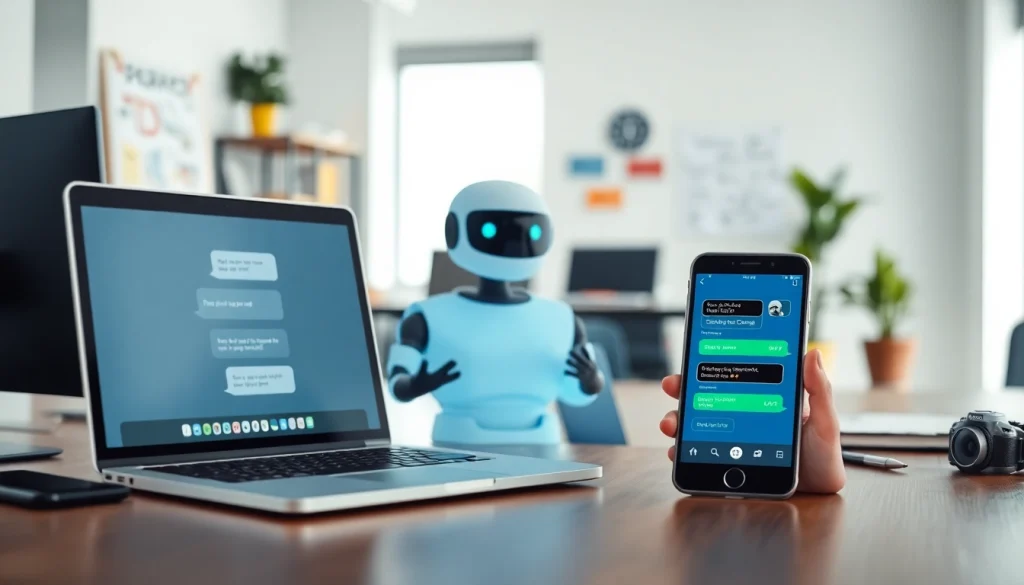Understanding the ChatGPT Chatbot
What is a ChatGPT Chatbot?
In the rapidly evolving landscape of artificial intelligence, the chatgpt chatbot stands out as a revolutionary tool for enhancing communications both in consumer and business environments. At its core, a ChatGPT chatbot utilizes advanced natural language processing (NLP) models to engage in human-like conversation, responding intelligently to user inquiries, providing information, and assisting in real-time problem-solving. These chatbots can be deployed across various platforms, including websites, social media, and customer service portals, vastly improving the way organizations interact with their stakeholders.
How Does the ChatGPT Chatbot Work?
The mechanics behind the ChatGPT chatbot hinge on sophisticated machine learning algorithms, particularly those designed for understanding and generating human language. Developed by OpenAI, the Generative Pre-trained Transformer (GPT) models are trained on diverse datasets, allowing them to understand context and generate coherent, contextually relevant responses. As users interact with the chatbot, the system analyzes the input data, leveraging its training to determine the most appropriate response. This dynamic interaction enables not only basic recognition of inquiries but also the generation of nuanced dialogue that can adapt over time based on user feedback and changes in conversational context.
Key Features of ChatGPT Chatbots
- Natural Language Understanding: The ability to comprehend user input effectively, grasping both intent and sentiment.
- Real-time Response Generation: ChatGPT can generate answers instantly, making it ideal for time-sensitive inquiries.
- Multilingual Support: This feature allows chatbots to engage with users across different languages, expanding their usability.
- Integration Capabilities: These chatbots can seamlessly integrate with various software and APIs, enhancing functionality.
- Learning and Adaptation: Through machine learning, the chatbot refines its responses and improves user interactions over time.
Benefits of Implementing a ChatGPT Chatbot
Improving Customer Engagement
Customer engagement is pivotal in driving loyalty and satisfaction in today’s competitive market. A ChatGPT chatbot can significantly enhance customer interaction by delivering personalized experiences. By analyzing past interactions, preferences, and behaviors, the chatbot can tailor conversations and provide recommendations that resonate with the user. This personalized approach increases user engagement, leading to higher conversion rates and nurturing long-term relationships with customers. Moreover, the availability of chatbots 24/7 ensures that customers receive immediate assistance regardless of time constraints, which is critical in an increasingly globalized business environment.
Boosting Operational Efficiency
Incorporating a ChatGPT chatbot into business operations can streamline various processes, thereby improving overall efficiency. By handling routine inquiries and tasks, such as appointment scheduling, basic troubleshooting, and information dissemination, the chatbot frees up human agents to focus on more complex issues that require human judgment and emotional intelligence. This shift not only optimizes workforce allocation but also enhances operational productivity. Furthermore, the analytical capabilities of these chatbots allow businesses to gather insights from customer interactions, enabling data-driven decisions that bolster strategic growth.
Enhancing User Experience
User experience is a critical determinant of success in any customer-facing industry. The implementation of a ChatGPT chatbot can significantly enhance this experience through instant access to information and support. Users benefit from the chatbot’s quick response times, availability, and the ability to resolve issues without the need for lengthy interactions with customer service representatives. Additionally, the consistency and reliability of chatbot interactions contribute to user satisfaction, which is essential for fostering brand loyalty.
Best Practices for ChatGPT Chatbot Deployment
How to Customize Your ChatGPT Chatbot
To maximize the effectiveness of a ChatGPT chatbot, customization is key. Organizations should begin by defining the chatbot’s objectives, such as improving customer service, guiding users through a sales funnel, or providing technical support. Customizing the chatbot’s voice and tone to align with the brand’s personality is also crucial. This ensures that interactions feel genuine and relatable. Developing tailored responses based on user personas can create a more engaging experience for users, enhancing the alignment between the bot’s capabilities and user expectations.
Integrating ChatGPT with Existing Systems
Effective integration of a ChatGPT chatbot with existing systems, such as customer relationship management (CRM) software, e-commerce platforms, and other operational tools, is essential for comprehensive functionality. This allows the chatbot to access and process relevant data, enabling it to provide personalized responses and context-aware support. APIs (application programming interfaces) can facilitate smooth integrations, ensuring that data flows seamlessly between the chatbot and other systems. A well-integrated chatbot can deliver enhanced service levels, yielding improved customer satisfaction and operational efficiency.
Monitoring and Continuous Improvement
Deployment of a ChatGPT chatbot should not be the end of the process; continuous monitoring and improvement are essential for maintaining its effectiveness. Businesses should implement performance metrics to evaluate the chatbot’s interactions, focusing on aspects like response accuracy, user satisfaction, and engagement rates. Regular updates and curriculum adjustments based on user feedback and interaction analytics can help to fine-tune the bot’s performance. Additionally, training the model with new data can further enhance its understanding and responsiveness, enabling it to adapt to emerging trends and customer needs.
Real-World Applications of the ChatGPT Chatbot
Case Studies in Different Industries
Various industries have embraced ChatGPT chatbots, yielding notable successes. For example, in the e-commerce sector, retailers have implemented chatbots to assist customers in finding products and completing purchases. By doing so, they have seen improvements in conversion rates and reductions in cart abandonment. In health care, chatbots are being utilized to provide patients with immediate responses to inquiries regarding symptoms or appointment scheduling, leading to better patient experiences. Similarly, in financial services, companies leverage chatbots to assist clients with account inquiries and transaction issues, streamlining customer service while maintaining compliance with regulatory standards.
Lessons Learned from Successful Implementations
Successful implementations of ChatGPT chatbots often highlight the importance of clear objectives and continuous user testing. Organizations have discovered that starting with a specific use case, such as customer service or lead generation, can lead to more effective training and a better user experience. Additionally, involving stakeholders early in the deployment process fosters a sense of ownership and encourages collaboration in refining the chatbot’s functionality and user interface. Flexibility and responsiveness to user feedback emerge as themes in successful use cases, demonstrating that adaptability is key to long-term success.
The Future of AI Chatbots in Business
The future of AI chatbots, particularly those powered by advanced models like ChatGPT, is promising. As businesses increasingly adopt AI technologies, chatbots will evolve to provide even more sophisticated interactions, utilizing not just text but potentially voice and visual interfaces as well. The integration of AI with machine learning allows for more profound personalization of user interactions, which could redefine customer service standards across industries. Furthermore, as machine learning algorithms improve, chatbots will become more adept at recognizing emotions and sentiments, paving the way for richer, more human-like conversations that enhance engagement and foster deeper connections with users.
Measuring Success with ChatGPT Chatbots
Key Metrics for Evaluation
To evaluate the effectiveness of a ChatGPT chatbot, organizations must focus on key performance indicators (KPIs) that reflect its impact on business objectives. Metrics such as average response time, user satisfaction scores, and conversation resolution rates are fundamental in assessing efficiency. Additionally, tracking engagement metrics—such as user retention and interaction depth—can provide insights into the chatbot’s success in maintaining customer interest. Businesses should also monitor conversion rates associated with chatbot interactions to determine its contribution to sales growth or service efficiency.
Tools for Analyzing Chatbot Performance
Numerous analytics tools are available to help organizations monitor and enhance chatbot performance. Platforms like Google Analytics can provide insights into user behavior within chat interfaces, including visitor demographics and interaction patterns. Specialized chatbot analytics tools, such as Botanalytics or Chatbase, are designed specifically to track conversation flows, user interactions, and dropout rates. Leveraging these tools enables businesses to gather actionable insights, allowing for continual refinement and optimization of their ChatGPT chatbot systems.
Adapting Strategies Based on Data Insights
Successful implementation of ChatGPT chatbots demands a data-driven approach to strategy adaptation. As organizations gather performance data over time, they must be ready to pivot based on insights gleaned from user interactions. For instance, if a particular response or feature is underperforming, it may warrant revisiting the training data or refining the conversational scripts. Additionally, shifting market trends or user preferences may necessitate rapid adjustments to the chatbot’s capabilities. An agile approach, underpinned by data insights, allows businesses to stay ahead of the curve and continually meet customer needs effectively.





